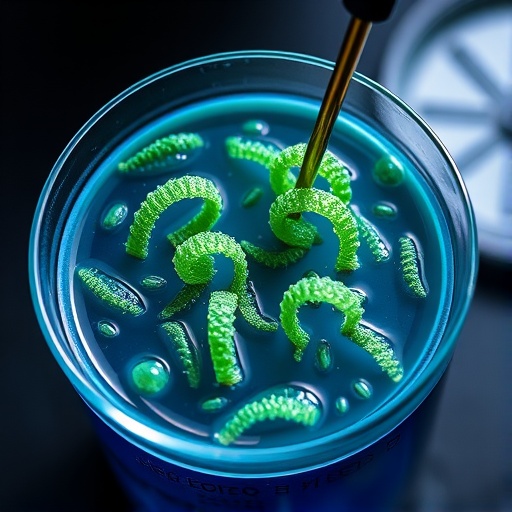In a groundbreaking development within the realm of food science, Cornell University researchers have successfully engineered a novel natural blue food dye derived from the protein phycocyanin (PC), extracted from algae. This innovation offers a sustainable alternative to synthetic food colorants traditionally made from petroleum-based sources. The research highlights not only the potential of phycocyanin as a vibrant colorant but also its dual functionality as a natural emulsifier, addressing consumer demand for cleaner, healthier food ingredients.
Published in the prestigious journal Food Hydrocolloids, the study spearheaded by Alireza Abbaspourrad and his team explores the significant advancements in the stability and efficacy of phycocyanin. In recent years, consumers have increasingly expressed a desire for food products devoid of artificial additives, driving the movement towards “clean labels.” Qike Li, a doctoral candidate and the lead author of the study, emphasized the urgency of providing healthier and more natural alternatives that satisfy this growing consumer trend.
Despite its vivid blue color, phycocyanin faces challenges regarding stability during processing and storage; it is particularly sensitive to heat and light, which can compromise its integrity. This limitation has historically made it difficult to incorporate into various food formulations successfully. The Cornell team realized that to unlock the full potential of phycocyanin, they needed to deconstruct it into more manageable components. Utilizing a denaturant, they reorganized the protein structure from larger, uneven polymers into smaller, homogeneous particles, significantly enhancing the emulsifying properties of phycocyanin.
.adsslot_U5jzXuPCJO{width:728px !important;height:90px !important;}
@media(max-width:1199px){ .adsslot_U5jzXuPCJO{width:468px !important;height:60px !important;}
}
@media(max-width:767px){ .adsslot_U5jzXuPCJO{width:320px !important;height:50px !important;}
}
ADVERTISEMENT
The innovative approach facilitated the creation of emulsions that not only exhibit a striking blue hue but also possess the capability to protect and deliver essential nutrients in oil. This dual-purpose functionality distinguishes phycocyanin from its synthetic counterparts, which often lack the ability to contribute additional health benefits. In essence, the team’s work shifts the paradigm from merely supplementing food with colorants to enhancing the overall nutritional profile of food products using a natural source.
To evaluate the structural changes and performance of the reconfigured phycocyanin, the researchers employed a sophisticated technique known as small angle X-ray scattering (SAXS). This method allows scientists to visualize materials at a nanoscale, akin to using a magnifying glass that provides insights into the intricate architecture of proteins. Such analyses are crucial for understanding how structural modifications can impact functionality and stability in food applications.
Furthermore, the research arrives at a pivotal moment in the broader discussion surrounding artificial food dyes in the United States. Regulatory scrutiny has increased dramatically, with various states considering legislation to eliminate several synthetic color additives from consumer products. Notably, recent bans on Red No. 3 and impending restrictions on other dyes like Blue No. 1 and Yellow No. 5 illustrate a significant shift towards advocating for safer, more natural food options.
The empirical findings from Cornell’s research may provide the food industry with a broad array of new possibilities, enabling manufacturers to transition away from synthetic dyes and toward preservatives that align with consumer preferences for transparency and health. Moreover, the promise of phycocyanin’s multifunctionality sets it apart from existing alternatives like spirulina, which has gained traction as a food coloring but often lacks the same stability and performance characteristics.
Ultimately, the study not only opens the door to the widespread use of phycocyanin in food products but also underscores the necessity of sustainable practices in food science. With consumers increasingly pushing for safer and more natural ingredients, innovations like those presented by the Cornell research team could resonate throughout the culinary landscape, permanently altering the fabric of how food is colored and preserved across the globe.
In conclusion, the development of a stable, algae-derived blue food dye marks a significant advance in food technology. Its integration could mitigate the environmental impacts associated with synthetic dyes while also catering to consumer desires for clean, health-oriented products. As the research moves forward, the potential applications of phycocyanin could redefine standards in food coloration, leading the charge towards a greener, healthier food industry.
Subject of Research: Natural Blue Food Dye from Phycocyanin
Article Title: Elucidating structure-functionality relationships of phycocyanin through size-exclusion chromatography coupled with in-line small-angle X-ray scattering
News Publication Date: 24-Jul-2025
Web References: Food Hydrocolloids
References: DOI: 10.1016/j.foodhyd.2025.111798
Image Credits: Cornell University
Keywords
Food additives, Food science, Applied sciences and engineering
Tags: advancements in food coloring technologyalgae-based food innovationschallenges of phycocyanin stabilityclean label food productsconsumer demand for healthier ingredientsCornell University food science researchfood hydrocolloids researchnatural blue food dyenatural emulsifiers in foodphycocyanin extraction from algaesustainable food colorantssynthetic vs natural food additives





